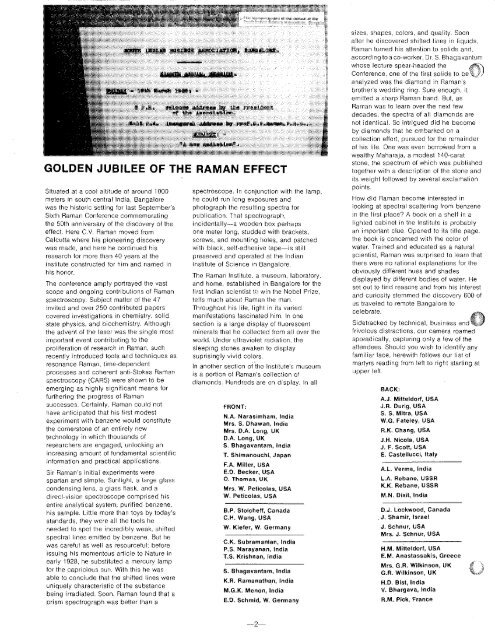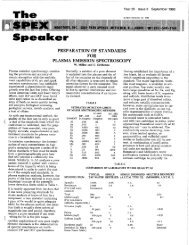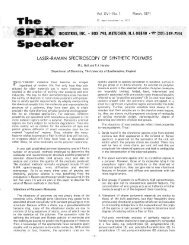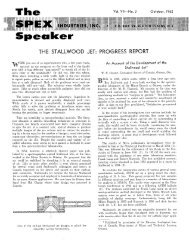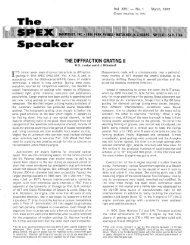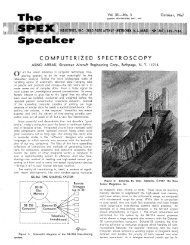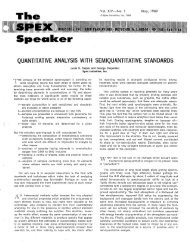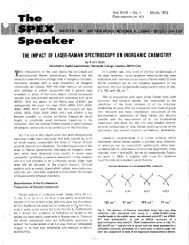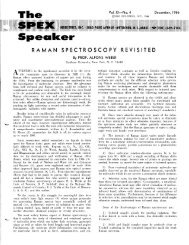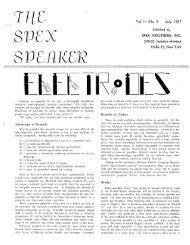Raman Anniversary Issue - Golden Jubilee Of The ... - SPEX Speaker
Raman Anniversary Issue - Golden Jubilee Of The ... - SPEX Speaker
Raman Anniversary Issue - Golden Jubilee Of The ... - SPEX Speaker
You also want an ePaper? Increase the reach of your titles
YUMPU automatically turns print PDFs into web optimized ePapers that Google loves.
GOLDEN JUBILEE OF THE RAMAN EFFECT<br />
Situated at a cool altitude of around 1000<br />
meters in south central India, Bangalore<br />
was the historic setting for last September's<br />
Sixth <strong>Raman</strong> Conference commemorating<br />
the 50th anniversary of the discovery of the<br />
effect. Here CV <strong>Raman</strong> moved from<br />
Calcutta where his pioneering discovery<br />
was made, and here he continued his<br />
research for more Ulan 40 years at the<br />
institute constructed for him and named in<br />
his honor.<br />
<strong>The</strong> conference amply portrayed the vast<br />
scope and ongoing contributions of <strong>Raman</strong><br />
spectroscopy. Subject matter of the 4 7<br />
invited and over 250 contributed papers<br />
covered investigations in chemistry, solid<br />
state physics, and biochemistry. Although<br />
the advent of the laser was the single most<br />
important event contributing to the<br />
proliferation of research in <strong>Raman</strong>, such<br />
recently introduced tools and techniques as<br />
resonance <strong>Raman</strong>, time-dependent<br />
processes and coherent anti-Stokes <strong>Raman</strong><br />
spectroscopy (CARS) were shown to be<br />
emerging as highly significant means lor<br />
furthering the progress of <strong>Raman</strong><br />
successes. Certainly, <strong>Raman</strong> could not<br />
have anticipated that his first modest<br />
experiment with benzene would constitute<br />
the cornerstone of an entirely new<br />
technology in which thousands of<br />
researchers are engaged, unlocking an<br />
increasing amount of fundamental scientific<br />
information and practical applications.<br />
Sir <strong>Raman</strong>'s initial experiments were<br />
spartan and simple. Sur1lighl, a Iorge gla::;s<br />
condensing lens, a glass flask, and a<br />
direct-vision spectroscope comprised f1is<br />
entire analytical system; purified benzene,<br />
his sample. Little more than toys by today's<br />
standards, they were all the tools he<br />
needed to spot the incredibly weak, shifted<br />
spectral lines emitted by benzene. But he<br />
was careful as well as resourceful: before<br />
issuing his momentous article to Nature in<br />
early 1928, he substituted a mercury lamp<br />
for the capricious sun. With this he was<br />
able to conclude that the shifted lines were<br />
uniquely characteristic of the substance<br />
being irradiated. Soon, <strong>Raman</strong> found that a<br />
prism spectrograph was better than a<br />
spectroscope. In conjunction with the lamp,<br />
he could run long exposures and<br />
photograph the resulting spectra for<br />
publication. That spectrograph,<br />
incidentally-a wooden box perhaps<br />
one meter long, studded with brackets,<br />
screws, and mounting holes, and patched<br />
with black, self-adhesive tape-is still<br />
preserved and operated at the Indian<br />
Institute of Science in Bangalore.<br />
<strong>The</strong> <strong>Raman</strong> Institute, a museum, laboratory,<br />
and home, established in Bangalore for the<br />
first Indian scientist to win the Nobel Prize,<br />
tells much about <strong>Raman</strong> the man.<br />
Throughout his life, light in its varied<br />
manifestations fascinated him. In one<br />
section is a large display of fluorescent<br />
minerals that he collected from all over the<br />
world. Under ultraviolet radiation. the<br />
sleeping stones awaken to display<br />
suprisingly vivid colors.<br />
In another section of the Institute's museum<br />
is a portion of <strong>Raman</strong>'s collection of<br />
diamonds. Hundreds are on display, in all<br />
FRONT:<br />
N.A. Narasimham, India<br />
Mrs. S. Dhawan, India<br />
Mrs. D.A. Long, UK<br />
D.A. Long, UK<br />
S. Bhagavantam, India<br />
T. Shimanouchi, Japan<br />
F.A. Miller, USA<br />
E. D. Becker, USA<br />
0, Thomas, UK<br />
Mrs. W. Peticolas, USA<br />
W. Peticolas, USA<br />
B.P. Stoicheff, Canada<br />
C.H. Wang, USA<br />
W. Kiefer, W. Germany<br />
C.K. Subramanian, India<br />
P.S. Narayanan, India<br />
T.S. Krishnan, India<br />
S. Bhagavantam, India<br />
K.R. <strong>Raman</strong>atha.n, India<br />
M.G.K. Menon, India<br />
E. D. Schmid, W. Germany<br />
sizes, shapes, colors. and quality. Soon<br />
after he discovered shifted lines in liqu1ds,<br />
<strong>Raman</strong> turned lois attention to solids and,<br />
according to a co-worker, Dr. S. Bhagavantum<br />
whose lecture spear~headed the ff\,'<br />
Conference, one of the first solids to be 1 ~))<br />
analyzed was the diamond in <strong>Raman</strong>·s<br />
brother"s wedding ring. Sure enough, it<br />
emitted a sharp <strong>Raman</strong> band. But, as<br />
<strong>Raman</strong> was to learn over the next few<br />
decades, the spectra of all diamonds are<br />
not identical. So intrigued did he become<br />
by diamonds that he embarked on a<br />
collection effort, pursued for tile remainder<br />
of his life. One was even borroWed from a<br />
wealthy Maharaja, a modest 140-carat<br />
stone, the spectrum of which was published<br />
together with a description of the stone and<br />
its weight followed by several exclamation<br />
points.<br />
How did <strong>Raman</strong> become interested in<br />
looking at spectral scattering from benzene<br />
in the first place? A book on a shelf in a<br />
lighted cabinet in the Institute is probably<br />
an important clue. Opened to its title page.<br />
the book is concerned with the color of<br />
water. Trained and educated as a natural<br />
scientist, <strong>Raman</strong> was surprised to learn that<br />
there were no rational explanations for the<br />
obviously different hues and shades<br />
displayed by different bodies of water. He<br />
set out to find reasons and from his interest<br />
and curiosity stemmed the discovery 600 of<br />
us traveled to remote Bangalore to<br />
celebrate. .,,<br />
Sidetracked by technical, business and(:$:;<br />
frivolous distractions, our camera roamed<br />
sporadically, capturing only a few of the<br />
attendees. Should you wish to identify any<br />
familiar face, herewith follows our list of<br />
martyrs reading from lelt to right starting at<br />
upper left<br />
BACK:<br />
A.J. Mitteldorf, USA<br />
J.R. Durig, USA<br />
S. S. Mitra, USA<br />
W.G. Fateley, USA<br />
R.K. Chang, USA<br />
J.H. Nicola, USA<br />
J. F. Scott, USA<br />
E. Castellucci, Italy<br />
A.L. Verma, India<br />
L.A. Rebane, USSR<br />
K.K. Rebane, USSR<br />
M.N. Dixit, India<br />
D.J. Lockwood, Canada<br />
. J. Shamir, Israel<br />
J. Schnur, USA<br />
Mrs. J. Schnur, USA<br />
H.M. Mitteldorf, USA<br />
E.M. Anastassakis, Greece<br />
Mrs. G.R. Wilkinson, UK<br />
G.R. Wilkinson, UK<br />
H.D. Blst, India<br />
V. Bhargava, India<br />
A.M. Pick, France<br />
-2-


